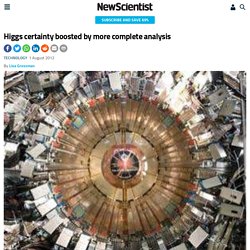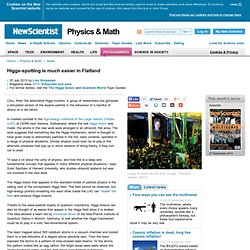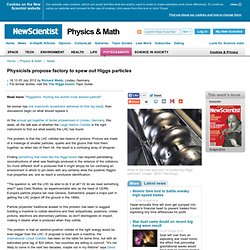

What if we could split the Higgs boson? - physics-math - 12 July 2012. Read more: " Higgsteria: Hunting the world's most wanted particle " The standard model of particle physics assumes the Higgs boson is an elementary particle.

But what if, rather like the proton, it is itself made up of particles? We know the standard model is incomplete because it cannot explain all the phenomena we observe (see " Beyond Higgs: Deviant decays hint at exotic physics "). Tweaking the model to make the Higgs a composite of quark-like particles, bound together by a new force, could solve this problem. It turns out that there is more than one way to arrange these new particles and forces to produce something akin to dark matter . To see if the boson reported last week at CERN near Geneva, Switzerland, could be such a composite, Alex Pomarol from the Autonomous University of Barcelona in Spain has started to compare decay data for the new particle with predictions of how a composite Higgs would decay inside the Large Hadron Collider.
Have your say. Higgs certainty boosted by more complete analysis - physics-math - 01 August 2012. By Lisa Grossman Its discovery last month sparked a media storm but the Higgs boson is now even more of a sure thing.

ATLAS, one of the two experiments behind the original discovery, has carried out a more complete analysis that boosts the statistical significance of the Higgs signal even further. The analysis also shores up the classification of the particle as a Higgs boson – though whether this is exactly the Higgs boson predicted by the standard model of particle physics, or one with slightly different properties has yet to be nailed. On 4 July, the twin detectors at the Large Hadron Collider near Geneva, Switzerland – CMS and ATLAS – announced that they had finally found the long-sought Higgs boson, the last missing piece of the standard model and the particle credited with giving other particles mass. The Higgs wasn’t glimpsed directly: once it is created inside the detector it decays so quickly that it can only see the other particles the boson decays into. Higgs-spotting is much easier in Flatland - physics-math - 25 July 2012.
CALL them the alternative Higgs hunters.

A group of researchers has glimpsed a simulated version of the elusive particle in the behaviour of a handful of atoms on a lab bench. In marked contrast to the high-energy collisions of the Large Hadron Collider (LHC) at CERN near Geneva, Switzerland, where the real Higgs boson was made, the atoms in the new work were arranged in an ultracold, flat array. The work suggests that something like the Higgs mechanism, which is thought to have given mass to elementary particles in the hot, early universe, operates in a range of physical situations. Similar physics could even be at play in the alternate universes that pop up in some versions of string theory, if they turn out to exist.
"It says a lot about the unity of physics, and how this is a deep and fundamental concept that appears in many different physical situations," says Subir Sachdev of Harvard University, who studies ultracold systems but was not involved in the new work. Promoted Stories. Physicists propose factory to spew out Higgs particles - physics-math - 05 July 2012. Read more: "Higgsteria: Hunting the world's most wanted particle" No sooner has one mammoth accelerator delivered its first big result, than discussions begin on what should replace it.

At the annual get-together of Nobel prizewinners in Lindau, Germany, this week, all the talk was of whether the Large Hadron Collider is the right instrument to find out what exactly the LHC has found. The problem is that the LHC collides two beams of protons. Protons are made of a melange of smaller particles, quarks and the gluons that hold them together, so when two of them hit, the result is a confusing array of shrapnel. Finding something that looks like the Higgs boson has required painstaking reconstructions of what was fleetingly produced in the violence of the collisions. "The question is, will the LHC be able to do it at all? Particle physicists' traditional answer to this problem has been to suggest building a machine to collide electrons and their antiparticles, positrons. Muon-smasher.